The first words of the Monclova Mint in 200 years!
by Ricardo de León Tallavas
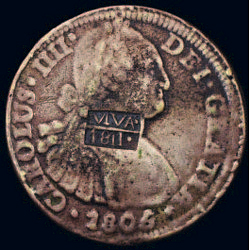
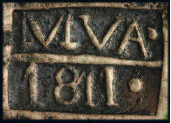
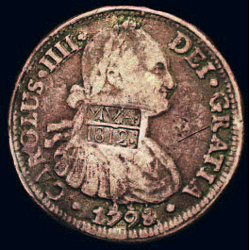
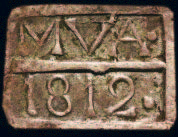
This article could easily be one of the most important breaks in Mexican numismatics of the Mexican War of Independence.
Ever since the 1930s when Pradeau started writing about the history of the Mexican mints two gaps have been persistently present. Every Mexican mint has been researched and amply published, except for two: Sombrerete and Monclova. These two War of Independence mints have the fascination of having very crude and very scarce to rare issues, all of them very popular among collectors. Also, these issues were coined for barely two or two and a half years only which make them more attractive when found. The lack of documentation has made these two mints the victims of merely one or two paragraphs in every catalog or general numismatic reference since the 19th century. In some references the “MVA” validation punch mark has been misinterpreted as a royalist counter-stamp on different issues, while in reality it was applied at the mint exclusively and for the coins cast there since originColin Bruce, II, Standard Catalog of Mexican Coins, Paper Money, Stocks, Bonds and Medals, Krause Publications, Iola WI, 1981, pp. 25: Chester Krause et al., Standard Catalog of Spain, Portugal and the New World, Krause Publications, Iola, WI, 2002, p. 415..
The majority of the written research for the mints of Sombrerete and Monclova has just been of describing the coins themselves and hardly anything else. In the Mexican history books they have been just a casual mention ever since 1811. However, this is about to change, at least for one of them, the most intriguing mint of MonclovaAlberto Pradeau, Numismatic History of Mexico, Sanford J Durst, New York, 1978, pp. 73, 83, 91, 125 – 126: El Real de a Ocho Primera Moneda Universal, Fomento Cultural Banamex, México, 1976, p. 73: La Casa de Moneda de México a más de 450 años, Porrúa, Mexico City, 1989, p. 79.
The main reason of this lack of information resides in the outstanding circumstances in which every mint opened during the War of Independence, - the emergency mints as they were known back then. All of them, except for Zacatecas, were under the scrutiny of one single person, the governor of the far away Province of Chihuahua and the head of the Intendancy of the Western Provinces (Provincias Internas de Occidente), Nemesio Salcedo y Sierralta. He was the political and military chief for the provinces of Sonora, Chihuahua, New Mexico, the Californias (Higher and Lower),
Durango and Sinaloa. He had no legal authority in the provinces of Zacatecas (where the Sombrerete mint was located) or Coahuila (where the Monclova mint operated). Recently two pages on the Sombrerete mint were found giving some light to it: however, most of the workers listed are only quoted by their first nameLa Casa de Moneda de México a más de 450 años, p. 69.
This legal peculiarity of Salcedo being the sole overseer was such that the Intendant of Zacatecas ordered the Sombrerete mint to close in 1812. Among the reasons stated for its closure were that mint was located in the Province of Zacatecas, but its administration was done by Salcedo in the far Province of Chihuahua, and was not done for free. This fact was acutely aggravated by the fact that its revenues were sent to Chihuahua instead of staying in the Province of Zacatecas.
The mint of Monclova did not pertain to the administration of the Intendancy of the Western Provinces either. Legally, since 1787 it was a dependent of the administrative Treasury of the Intendancy of the Eastern Province, where Monterrey was the headquarters, in the Province of the Nuevo Reino de León. So the administration and reception of tax revenue legally belonged to Monterrey, not Chihuahua. How did this apparent legal bridge happen? The only logical explanation resides in the fact that newly arrived viceroy of New Spain, Francisco Xavier Venegas, did not know whom he could trust.
Venegas had been appointed by the Courts at Cadiz and had arrived in New Spain barely a few days before the eruption of insurgency by Father Hidalgo in Guanajuato in the middle of September 1810 José Herrera Peña, Hidalgo a la luz de sus escritos, Morevallado, Mexico City, 2003, pp. 29 – 32: Isidro Vizcaya Canales, En los albores de la independencia: las Provincias Internas de Oriente durante la insurrección de don Miguel Hidalgo y Costilla, 1810-1811, Mexico: Fondo Editorial Nuevo León, 2005, pp. XIII, 169, 228, 277, 298, 300.
However, Venegas did know Nemesio Salcedo since both had been in Spain. Venegas also knew he could trust him with the administration of the soon-to-be-opened emergency mints after they were decreed on 8 October 1810. The insurgency was dangerously close to the capital of the Vice-royalty of New Spain, Mexico City, and Venegas could not jeopardize the administration of these mints due the insurgent battles. If Mexico City fell, and Mexico’s mint with it, at least the rest of the emergency mints could provide resources for the resistance to this violent revolution. This situation of having Salcedo so distant created a circumstance of filing papers in different places, hence the long lack of information on the mint that operated in Monclova Josefina Vázquez, Interpretaciones sobre la Independencia de México, Mexico, 1997, pp. 44 : Charles Herbermann, The Catholic Encyclopedia, Presswork, Albany, New York, 1914, Vol. XVI, pp. 45: Aníbal Galindo, Las Batallas Decisivas de la Libertad, Garnier, París, France, 1888, pp. 198 and 199
The document that opened the door for this information resides in Saltillo, in the State Archives of Coahuila, and was produced in 1812. The reason for this important file to be made was the accusation of a very minor theft of silver at Monclova’s mint. This event sparked a 94 page file that revealed many names unknown to us for 200 years. It also gave two unexpected and very important twists.
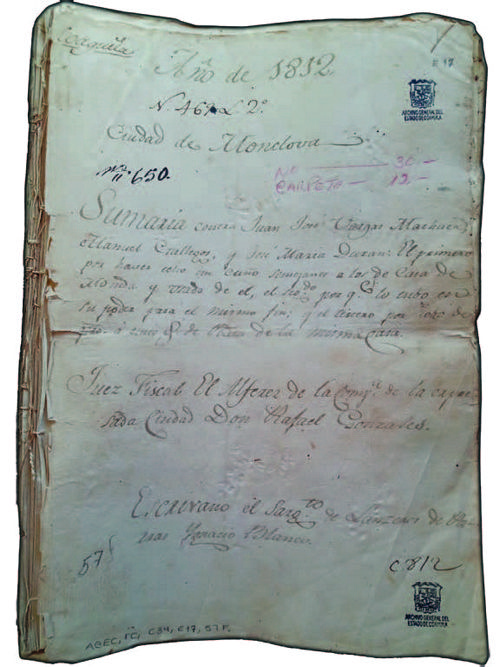
This document starts when on 23 May 1812 a “sumaria” (official investigation) was opened against a gentleman by the name of Juan José Vargas Machuca, very possibly a son or nephew of José Vargas Machuca, the Assayer of the Sombrerete Mint. Juan José had been born in Guadalajara, New Galicia, in New Spain and was stated as being 32 years of age at that point. He would be the central focus of this investigation. This document ends on 11 September of that year and finalizes this process with sentences for those involvedArchivo General del Estado de Coahuila., Fondo Colonial, caja 34, expediente 17, 57 fojas, Año de 1812: Ibidem, pp. 4 – 5, 35 – 37..
The investigation is very colorful and at times even naive. It was detonated by José Ignacio Quintero, also a silversmith, on behalf of the Senior Silversmith of the Monclova Mint, Jean Marc Marchand (a Frenchman) for theft of possibly a mark of silver (8.15 ounces). This silver was unaccounted for at the same time that some coins were found on Juan José Vargas Machuca, alongside recurrent rumors of him taking bits of silver. Vargas could not explain the origin of these pesos immediately, and the implication of a theft was a very serious charge regardless of the amount. Silversmiths were named in that investigation, and a timeline and a story were composed. One of the silversmiths, José María Durán, a young boy of merely 17 years of age, stole the said silver from the Coining Office and gave it to Juan José Vargas Machuca to make a silver sheet (“chapa”) which he didIbid., pp. 4 – 6, 9, 57 – 59..
Later on, Juan José Vargas Machuca gave this sheet of stolen silver to another silversmith, José María Durán, to cut some silver buttons out of that sheet, a very easy way to have small countable trading pieces of silver without making coins, and to avoid any suspicions arising. Thirty-nine of these buttons were cut and sold as silver to yet another silversmith, José Alcalá, who had no idea that this silver was stolen. Alcalá is named in that document as being the Assayer for the Monclova Mint (“…the one in charge of refining copper from silver…”)Ibid., pp 52 – 53, 28 – 29.
All of this could be trivial, but the first of the two mentioned twists came during the investigation. Juan José Vargas Machuca had made a die-validation-punch similar to the ones used at the Monclova mint to officially mark the cast coinage made there. A fake validation die! This twist gave a completely different dimension to this inquiry. This fake die was in all specifications exactly as those used at the mint as Vargas Machuca had seen Marchand exclusively make these since 1811 when the mint opened. On 8 July the Fiscal Judge Francisco González, who had opened the formal investigation on 23 May, was replaced by command of Coahuila’s Governor, Col. Antonio Cordero y Bustamante. He was replaced by Ramón Espinosa. The formal legal procedure against Juan José Vargas Machuca and the others implicated for the existence of this fake die was on its way. This procedure was also going to see if there were more fake dies around. From that point on Espinosa had to report also to Nemesio Salcedo in ChihuahuaIbid, pp, 13 – 14, 22 – 23.
The fake punch die was used on three pesos that Vargas Machuca had made, more than likely without assaying the purity and very possibly deliberately debased. He had heard of a grave illness that the brother of his co-worker Manuel Gallegos, the blacksmith of the mint, suffered. This illness prevented him from working and he was in a very dire situation. So, Juan José Vargas Machuca decided to loan him the die-validation-punch he had made “…just for eight days for Manuel Gallegos to make as many pesos of silver he could find in that said time…”Ibid., pp. 9 – 14, 18 – 19, 35 – 37, 44- 45, 57 – 58, 76, 89 – 93..
However, Gallegos could not make any pesos because he could not find any silver; after all he was only a blacksmith, not a silversmith. When the eight days passed Gallegos gave back the fake die validation-punch to Juan José Vargas Machuca, as promised. However, the die was defaced in the numbers and letters out of fear of Manuel Gallegos being found with it. Right after Vargas Machuca had the now useless fake die, he went to a cantina and pawned it to the lady that ran that place for one real of mescal (an alcoholic beverage) Ibid., pp. 35 – 37, 44 – 45, 57 – 59..
María Esmeregilda de Palos, also known as “María the Broach-Lady” (María la Abrochada), stated that she indeed had that useless die and had taken it as assurance of payment for Vargas’ schnapps, but she had no clue what it was. Also, she stated that Juan José Vargas Machuca had given her an alias when this die was left at her establishment. When she gave this useless die-validation-punch to the proper authorities it was recorded by a drawing in the open judiciary file. This is the only known drawing of how a die-validation-punch to officially mark cast coins looked at any of the official emergency mints in New Spain during the War of Independence! Ibid, pp. 35 – 38, 57 – 59, 92..
At the end, no one else used the fake die-validation-punch, other than Juan José Vargas Machuca. Three defenders for the imminent military trial were chosen by the three jailed detainees. For the young silver thief, José María Durán, was chosen Tomás Munguía, who based his defense on the fact that his defendant stated he did not do anything wrong other than witness the cutting of the said buttons; Durán never admitted to taking any silver. For the blacksmith, Juan Gallegos, was named Manuel Adrete, and the focus of his defense was that Gallegos did not use the die and even defaced it, his sin being not betraying a friend that tried to help him and his ill brother. Finally for the biggest culprit, Juan José Vargas Machuca, the defender was Tomás Oquilla: his defense was focused on that his client was an alcoholic that could not control his vice. Ibid., pp. 67 – 68, 73 – 74, 77 – 88..
Eventually the completed file of the investigation and legal trial against the three accused made its way to Chihuahua. The only recommendation from the judges in Coahuila of the three directly implicated and the jailed suspects was that José Vargas Machuca could receive 25 whippings for his illegal doings throughout this ordeal. The document on its way to Chihuahua ignored any recommendation for the other two. The sentences were delivered from Chihuahua by the Promotor Fiscal Judge, Bracho, on 18 August 1812, and were countersigned by Nemesio Salcedo. Their fate was delivered. The blacksmith, José Gallegos, had the mitigating evidence of never having used the said dievalidation-punch and even returned it defaced to Vargas Machuca. His only fault was that he did not betray his friend, understandably because Vargas wanted to help him and his brother. He was going to be set free as his time in the Monclova Headquarters jail had been enough to atone himIbid., pp. 64, 89 – 93..
José María Durán, the young silversmith who stole the silver that triggered this whole investigation, was also going to be set free as soon as the papers reached Monclova, but he had to work for free at the mint in order to repay those three or four pesos that he stole in silver. This benign sentence was inspired probably by his age of 17. As for Juan José Vargas Machuca, the sole creator of the fake die-validation-punch and the only one who actually used it, his sentence was that he had to remain in jail for the next four years. Due to the fact that the stamping of the fake pesos by a fake punch-die of his own making was not performed inside the mint building, Vargas’ life was spared. This document was signed by Bracho and countersigned by Nemesio Salcedo who forwarded it to the General Assessor, Col. Herrero, who acknowledged it, agreed with the sentences and also signed the fileIbid, pp. 95 – 97.
drawing of the dievalidation-punch
The second twist came on the last part of the last page of the file sent back from Chihuahua, signed by General Assessor Herrero, dated 20 August 1812. Herrero advises the Governor of Coahuila, Antonio Cordero y Bustamante, to review the security and quality at the mint. His words transpired the alarm of the government to the realization on how easy it was to replicate the validation punch by almost anyone that could get iron and a primitive forge. It is a fact that the mint in Monclova closed that year, very possibly soon after this document was received. Was this event the one that led to its closure?Ibid., p. 92.
The following year of 1813 the mint in Chihuahua, by then the only one that was still casting coins and then validating them by also punching them, barely made 290.000 coins. These coins were maybe issued by the first part of the year, and then nothing – even though almost 1.8 million coins are recorded, there is not a single one known after that until the re-coining of their previous cast coins in 1815. Was this apparent small event of the theft of barely 8.5 ounces and the creation of a fake die the cause leading to stopping coin casting altogether and the closure of one mint? It has been said that between 450,000 to two million pesos in silver bars were confiscated from the insurgency when Hidalgo and the others were captured near Monclova in March 1810 (in Baján, Coahuila). Was this confiscation of silver the origin of the mint at Monclova? Could it be that some of that silver confiscated from Father Hidalgo was the origin of some or most of the 1811 issue? Pradeau, op. cit. p. 86
| names mentioned in the 92 page document | |
| Administrator of the Intendancy of the Western Provinces and Governor of Chihuahua |
Nemesio Salcedo y Sierralta |
| Promotor Fiscal Judge of the Province of Chihuahua | Rafael Bracho |
| Governor of the Province de Coahuila | Coronel Antonio Cordero y Bustamante |
| Fiscal Judges in Monclova | Rafael González |
| Ramón Espinosa | |
| Juan Meléndez | |
| Military Notary at the Headquarters in Monclova | Ygnacio Blanco |
| Treasurer of the Monclova Mint and of the Province of Coahuila | Manuel Royuela * |
| Manager or Administrator (Director?) | José Manuel Casas, alias Gatica (30 years old) * |
| Silversmiths | Juan José Vargas Machuca (32 years old) * |
| José María Durán (17 years old) * | |
| Jean Marcos Marchand (47 years old) * | |
| Juan Castellano (29 years old) * | |
| Alexandro Estrada (28 years old) * | |
| José Ygnacio Quintero (20 years old) * | |
| José Ysidro Padilla (30 years old) * | |
| José Tomás Arredondo (34 years old) * | |
| Julián Rivas Yglesias Gallegos (25 years old) * (appears as Juan Gallegos) |
|
| Miguel López * | |
| Assayer (described as tuner of copper from silver) | José Alcalá (45 years old) * |
| Worker at the Office of Coining | José Ygnacio Galindo (39 years old) * |
| Blacksmith | Manuel Gallegos * |
| Military Defenders of the Accused | Tomás Oquilla |
| Tomás Munguía | |
| José Manuel Aldrete | |
| Members of the Military mentioned | Juan López (26 years old) |
| Pedro Bermea | |
| Francisco Padilla (40 years old) * | |
| José María Cárdenas Arizpe (27 years old) | |
| Francisco Padilla (40 years old) ** | |
| José María Sánchez | |
| Witness | María Esmeregilda de Palos (alias María “La Abrochada”) |
| * Worked at the mint ** Was present in the military skirmish that captured Hidalgo and the others in Baján in March 1810. |
|
